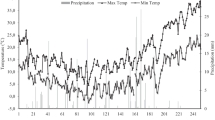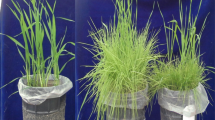Abstract
Aims
The incidence of herbicide-resistant blackgrass is escalating in wheat fields; the development of alternatives to traditional herbicides is crucial. Allelopathic wheat can suppress blackgrass. Herein, we investigated the influence of allelopathic wheat on herbicide-resistant blackgrass.
Methods
Mesosulfuron-methyl-resistant and -susceptible blackgrass were used. We examined i) root interactions between allelopathic wheat and both blackgrass biotypes, ii) allelochemical 2,4-dihydroxy-7-methoxy-1,4-benzoxazin-3-one (DIMBOA) production by allelopathic wheat in a root segregation experiment, and iii) responses of allelopathic wheat to root exudates. Signal chemicals in the root exudates of both blackgrass biotypes were characterised.
Results
Allelopathic wheat inhibited the growth of roots more than shoots for resistant and susceptible blackgrass. Allelopathic wheat inhibited roots of resistant blackgrass more than those of susceptible blackgrass. Allelopathic wheat significantly shaped blackgrass root behaviour. Resistant blackgrass caused a lower relative increase in DIMBOA production by allelopathic wheat. Root segregation with 30 μm nylon led to greater growth inhibition of blackgrass and a relative increase in allelochemical DIMBOA. Root exudates from blackgrass induced DIMBOA production, but more so for susceptible blackgrass. The concentration of (−)-loliolide, a potential signal chemical, was much lower in the root exudates from resistant than susceptible blackgrass.
Conclusions
Allelopathic wheat can interfere with the growth of mesosulfuron-methyl-resistant blackgrass through allelochemical-mediated root interactions. Such allelopathic interference can provide insight into weed management.







Similar content being viewed by others
References
Bajwa AA, Mahajan G, Chauhan BS (2015) Nonconventional weed management strategies for modern agriculture. Weed Sci 63:723–747
Beckie HJ (2006) Herbicide-resistant weeds: management tactics and practices. Weed Technol 20:793–814
Bertholdsson NO (2010) Breeding spring wheat for improved allelopathic potential. Weed Res 50:49–57
Bertholdsson NO (2011) Use of multivariate statistics to separate allelopathic and competitive factors influencing weed suppression ability in winter wheat. Weed Res 51:273–283
Bertholdsson NO (2012) Allelopathy—a tool to improve the weed competitive ability of wheat with herbicide-resistant black-grass (alopecurus myosuroides huds.). Agronomy 2:284–294
Callaway R, Pennings SC, Richards C (2003) Phenotypic plasticity and interactions among plants. Ecology 84:1115–1128
Chen KJ, Zheng YQ, Kong CH, Zhang SZ, Jing L, Liu XG (2010) 2,4-dihydroxy-7-methoxy-1,4-benzoxazin-3-one (DIMBOA) and 6-methoxy-benzoxazolin-2-one (MBOA) levels in the wheat rhizosphere and their effect on the soil microbial community structure. J Agric Food Chem 58:12710–12716
Chen BJW, During HJ, Anten NPR (2012) Detect thy neighbor: identity recognition at the root level in plants. Plant Sci 195:157–167
Dayan FE, Owens DK, Duke SO (2012) Rationale for a natural products approach to herbicide discovery. Pest Manag Sci 68:519–528
Duke SO (2012) Why have no new herbicide modes of action appeared in recent years? Pest Manag Sci 68:505–512
Gealy DR, Estorninos LE, Gbur EE, Chavez RSC (2005) Interference interactions of two rice cultivars and their F-3 cross with barnyardgrass (Echinochloa crus-galli) in a replacement series study. Weed Sci 53:323–330
Gu T, Li Y, Zhang Z, Zhang L, Yang X (2017) Quantification of herbicide-resistance of blackgrass (Alopecurus myosuroides) and selecting for efficient herbicides in rice-wheat rotation fields. Jiangsu Agricultral Science 48:94–97 (In Chinese)
Heap I (2014) Global perspective of herbicide-resistant weeds. Pest Manag Sci 70:1306–1315
Hedges LV, Gurevitch J, Curtis PS (1999) The meta-analysis of response ratios in experimental ecology. Ecology 80:1150–1156
Jabran K, Mahajan G, Sardana V, Chauhan BS (2015) Allelopathy for weed control in agricultural systems. Crop Prot 72:57–65
Kong C, Hu F, Wang P, Wu J (2010) Effect of allelopathic rice varieties combined with cultural management options on paddy field weeds. Pest Manag Sci 64:276–282
Kong CH, Chen XH, Hu F, Zhang SZ (2011) Breeding of commercially acceptable allelopathic rice cultivars in China. Pest Manag Sci 67:1100–1106
Kong CH, Zhang SZ, Li YH, Xia ZC, Yang XF, Meiners SJ, Wang P (2018) Plant neighbor detection and allelochemical response are driven by root-secreted signaling chemicals. Nat Commun 9:3867
Li YH, Xia ZC, Kong CH (2016) Allelobiosis in the interference of allelopathic wheat with weeds. Pest Manag Sci 72:2146–2153
Macías FA, Mejías FJ, Molinillo JM (2019) Recent advances in allelopathy for weed control: from knowledge to applications. Pest Manag Sci 75:2413–2436
Marina S, John EA, Hutchings MJ (2010) Effects of physical connection and genetic identity of neighbouring ramets on root-placement patterns in two clonal species. New Phytol 176:644–654
Marshall R, Moss SR (2008) Characterisation and molecular basis of ALS inhibitor resistance in the grass weed Alopecurus myosuroides. Weed Res 48:439–447
Metlen K, Aschehoug E, Callaway R (2009) Plant behavioural ecology: dynamic plasticity in secondary metabolites. Plant Cell Environ 32:641–653
Moss SR, Cocker KM, Brown AC, Linda H, Field LM (2003) Characterisation of target-site resistance to ACCase-inhibiting herbicides in the weed Alopecurus myosuroides (black-grass). Pest Manag Sci 59:190–201
Moss SR, Perryman SAM, Tatnell LV (2007) Managing herbicide-resistant Blackgrass (Alopecurus myosuroides): theory and practice. Weed Technol 21:300–309
Pheng S, Olofsdotter M, Jahn G, Adkins SW (2010) Potential allelopathic rice lines for weed management in Cambodian rice production. Weed Biol Manag 9:259–266
Przepiokowski T, Gorski SF (1994) Influence of rye (Secale cereale) plant residues on germination and growth of three triazine-resistant and susceptible weeds. Weed Technol 8:744–747
Rasmann S, Turlings TCJ (2016) Root signals that mediate mutualistic interactions in the rhizosphere. Curr Opin Plant Biol 32:62–68
Schmid C, Bauer S, Bartelheimer M (2015) Should I stay or should I go? Roots segregate in response to competition intensity. Plant Soil 391:283–291
Sun B, Wang P, Kong CH (2014) Plant-soil feedback in the interference of allelopathic rice with barnyardgrass. Plant Soil 377:309–321
Tang QY, Zhang CX (2013) Data processing system (DPS) software with experimental design, statistical analysis and data mining developed for use in entomological research. Insect Sci 20:254–260
Wardle DA, Bardgett RD, Klironomos JN, Heikki SL, van der Putten WH, Wall DH (2004) Ecological linkages between aboveground and belowground biota. Science 304:1629–1633
Wu H, Pratley J, Lemerle D, Haig T (2000) Evaluation of seedling allelopathy in 453 wheat (Triticum aestivum) accessions against annual ryegrass (Lolium rigidum) by the equal-compartment-agar method. Crop Pasture Sci 51:937–944
Wu H, Pratley J, Haig T (2003) Phytotoxic effects of wheat extracts on an herbicide-resistant biotype of annual ryegrass (Lolium rigidum). J Agric Food Chem 51:4610–4616
Xia ZC, Kong CH, Chen LC, Wang P, Wang SL (2016) A broadleaf species enhances an autotoxic conifers growth through belowground chemical interactions. Ecology 97:2283–2292
Yang XF, Kong CH, Yang X, Li YF (2017) Interference of allelopathic rice with penoxsulam-resistant barnyardgrass. Pest Manag Sci 73:2310–2317
Zhang SZ, Li YH, Kong CH, Xu XH (2016) Interference of allelopathic wheat with different weeds. Pest Manag Sci 72:172–178
Acknowledgements
We sincerely thank Prof. Ruth A. Hufbauer at Colorado State University for critical reading and English editing of the manuscript. This work was supported by the Scientific and Technological Innovation Fund of Shanxi Agricultural University (grant numbers 2018YJ19, 2017YJ17), the Talent Introduction Fund of Shanxi Province (SXYBKY2018010), and the National Natural Science Foundation of China (31800461).
Author information
Authors and Affiliations
Corresponding author
Ethics declarations
Conflict of interest
The authors declare that they have no conflict of interest.
Additional information
Responsible Editor: Hans Lambers.
Publisher’s note
Springer Nature remains neutral with regard to jurisdictional claims in published maps and institutional affiliations.
Electronic supplementary material
ESM 1
(DOCX 18 kb)
Rights and permissions
About this article
Cite this article
Yang, X., He, Y., Song, X. et al. Reduced growth responses of mesosulfuron-methyl-resistant blackgrass to allelopathic wheat are driven by underground chemical interaction. Plant Soil 448, 369–381 (2020). https://doi.org/10.1007/s11104-020-04439-x
Received:
Accepted:
Published:
Issue Date:
DOI: https://doi.org/10.1007/s11104-020-04439-x




